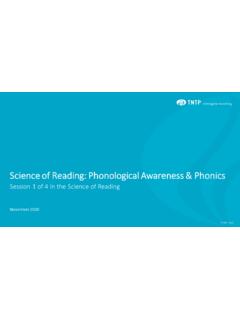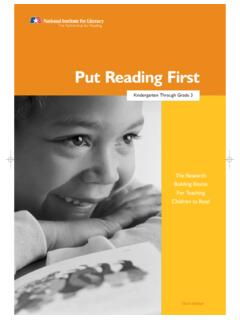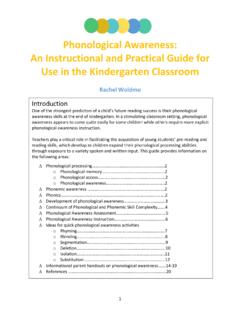Transcription of Oral language and beginning reading: Exploring …
1 Forum on Public Policy 1 Oral language and beginning reading : Exploring connections and disconnections Susan Hill, Associate Professor in Early Childhood Education, University of South Australia ABSTRACT The purpose of this study was to explore the connections between young children s oral language vocabulary and children s reading of written language in beginning reading books. Oral language has been viewed as the foundation for emergent reading development as it provides the semantic base, syntactic base and phonological base for successfully moving from oral to written language . In fact in the years before school the development of children s oral language in the home environment is viewed as an important factor for early reading success. The research reported in this study involved children in their first year of school in a socioeconomically diverse community.
2 The findings revealed disconnections between children s receptive oral language vocabulary and early reading . Children with English as a Second language scored low on oral language vocabulary but high on reading levelled texts. Children with high scores on oral vocabulary scored low on reading levelled texts and a small group of Aboriginal children scored low on both oral and written measures. This study raises questions about the view that oral language neatly underpins reading development and suggests that learning to read is akin to learning a second language for all children. And when he came to the place where the wild things are they roared their terrible roars and gnashed their terrible teeth and rolled their terrible eyes .. Where the wild things are (Sendak 1963). Introduction Oral language has long been regarded as the foundation for beginning reading as children draw on the meaning, syntax and the phonology of spoken language as a bridge to emergent literacy.
3 However, many teachers have commented on the vast diversity in the oral language capabilities of children starting school. In this case study of children in a small metropolitan school in Adelaide the teachers were concerned that some children were beginning school with relatively small vocabularies and some used forms of nonstandard oral language . The teachers thought that children with nonstandard forms of English syntax may have difficulty using the syntax of books or book language to aid their beginning reading . Also many schools have increasing numbers of children with English as an additional language as well as children who speak languages which have not been recorded in written form. The concern of these teachers led to a series of questions which are explored further through a review of literature and several case studies involving young children who are beginning to read emergent texts in their first year of school.
4 Oral language as a predictor of early reading The importance of oral language as a predictor of future literacy achievement is supported by research across a number of oral language domains. Young children need to have control over several aspects of oral language prior to starting the beginning to read process Forum on Public Policy 2 phonology, vocabulary, syntax, discourse and pragmatics (Snow, Burns and Griffin 1998). Research has shown that the size of children s vocabulary at age 3 is strongly associated with learning to read and reading comprehension at the end of third grade (Hart and Risley 2003). Dickinson and Tabors (2002) found the scores that kindergarteners achieved on measures (receptive vocabulary, narrative production, and emergent literacy) were highly predictive of their scores on reading comprehension and receptive vocabulary in fourth and seventh grade.
5 There are several characteristics of oral language : word meanings (semantics), sentence structure (syntax), the architecture of words and word parts (morphology) and sounds (phonology) (Richgels 2004). The particular characteristics of oral language phonology, vocabulary and syntax will be explored and compared to written language . Oral language and written language Oral language is all around us and we take it for granted, unaware of the choices we make or the form of language we use. However, when writing, written language demands that there is conscious attention to form and this involves choices to do with semantics, syntax and phonology. For example, a four year old beginning invented speller who wants to write I have a chair has to consider word order and meanings and when writing the word 'chair' the child needs to pay attention to phonemes in a way that they never had to when learning to speak (Richgels 2004).
6 The importance of phonological awareness cannot be underestimated and Richgels (2004) points out that children are born able to perceive phonemes for example from birth they can perceive the difference between /s/ and /z/. Richgels (2004) also writes that in the study of oral language the greatest attention in research has been on phonology, and even then, mostly on a subset of phonological knowledge; the awareness of phonemes. The syntax of oral language has been identified as important for beginning reading . It is argued that children with a high competence in oral language sentence construction bring rich language to the new task of reading and writing. The Record of Oral language (ROL), (Clay et al. 2007) was developed to measure children s syntax. However many of the sentences in the ROL have a structure similar to written language which uses more complex embedded syntax structures.
7 In contrast to written language the syntactic structure of oral language is more likely to be fragmented with clauses and phrases strung together, false starts and repetitions and abandoned intonation units (Purcell-Gates 2001). For example it is obvious there is a difference between oral and written language syntax when comparing an oral speech with a written statement which is read aloud. A child s oral vocabulary development is one of the most visible and important aspects of language acquisition in children (Richgels 2004). The number of words in a child s vocabulary is an indicator of his or her linguistic health and a factor in his or her ability to use language in varied contexts and for multiple purposes. The everyday spoken language that children hear has fewer rare words compared to the rare words that occur in books read aloud.
8 Hayes and Ahrens (1988) state that the lexical input from conversations are a limited source of learning new words outside of the 5,000 most common terms. To develop lexical knowledge requires extensive reading across a broad range of subjects. Young children's oral language vocabulary, when enhanced through the shared reading of picture books either in English or their primary language , has been shown to strengthen the vocabulary acquisition of English- language learners (Roberts 2008). The development of children s vocabulary and syntax are related to either hearing books read aloud and from independent reading . Purcell-Gates (2001) argues that oral language is not directly relevant to the study of emergent literacy because oral language , including its vocabulary, syntax and conventions Forum on Public Policy 3 differs in significant ways to written language .
9 She writes that concerns about children s home language environments and preschool experiences are only relevant to the degree that they affect written language knowledge. In other words reading and writing should be concerned with the conceptual and procedural knowledge of how written language works and not with how standard or non-standard oral language constitutes the base upon which literacy develops. Compared to spoken language , the act of writing takes more time. As well as being more time consuming the syntax of written text is embedded with more adjectival and adverbial sentence clauses whereas spoken language consists of more fragments, repetitions and false starts. The vocabulary of written language reflects a greater range of vocabulary choice perhaps because there is more time to choose words than when engaged in a spontaneous conversation.
10 With oral language vocabulary noted as an important link in learning to read it was assumed in this research that a child s vocabulary would neatly link to their reading proficiency. The children who had a rich vocabulary were assumed to be the more effective readers Method The study took place in a school in metropolitan Adelaide where the students come from a diverse range of cultural backgrounds. Many cultures were represented including many recently arrived immigrants from Iraq, Afghanistan, Serbia, Sudan and other African countries as well as a small cohort of Aboriginal students. The school has a high proportion of low income families with 60-65% of families eligible for School Card. The high level of complexity and diversity among the school population is considered a strength. The challenge is to develop relevant, explicit and challenging learning and teaching programs and practices that support a diverse range of learning needs and abilities.


















